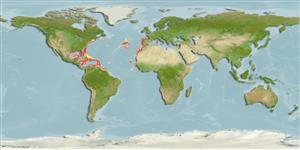>
Aulopiformes (Grinners) >
Ipnopidae (Deep-sea tripod fishes) > Ipnopinae
Etymology: Bathypterois: Greek, bathys = deep + Greek, pterois = with wings (Ref. 45335).
Environment: milieu / climate zone / depth range / distribution range
Ecologia
marino batidemersale; distribuzione batimetrica 476 - 1477 m (Ref. 3590). Deep-water; 45°N - 5°N
Eastern Atlantic: Cape Verde and off Liberia. Western Atlantic: between 45°N and 5°N (numerous records in the Pan-Caribbean region).
Size / Peso / Age
Maturity: Lm ? range ? - ? cm
Max length : 22.2 cm SL maschio/sesso non determinato; (Ref. 3590); common length : 19.0 cm SL maschio/sesso non determinato; (Ref. 3590)
Short description
Chiavi di identificazione | Morfologia | Morfometria
Spine dorsali (totale) : 0; Raggi dorsali molli (totale) : 12 - 13; Spine anali: 0; Raggi anali molli: 11 - 12. Pelvic and lower caudal rays prolonged; subcaudal notch absent (Ref. 13608).
Found on continental slopes. Synchronously hermaphroditic (Ref. 3590).
Life cycle and mating behavior
Maturità | Riproduzione | Deposizione | Uova | Fecundity | Larve
Merrett, N.R., 1990. Chlorophthalmidae. p. 351-360. In J.C. Quero, J.C. Hureau, C. Karrer, A. Post and L. Saldanha (eds.) Check-list of the fishes of the eastern tropical Atlantic (CLOFETA). JNICT, Lisbon; SEI, Paris; and UNESCO, Paris. Vol. 1. (Ref. 3590)
IUCN Red List Status (Ref. 130435: Version 2024-2)
Threat to humans
Harmless
Human uses
Strumenti
Special reports
Download XML
Fonti Internet
Estimates based on models
Preferred temperature (Ref.
123201): 5.1 - 12.1, mean 7.2 °C (based on 150 cells).
Phylogenetic diversity index (Ref.
82804): PD
50 = 0.5000 [Uniqueness, from 0.5 = low to 2.0 = high].
Bayesian length-weight: a=0.00479 (0.00191 - 0.01202), b=3.03 (2.81 - 3.25), in cm total length, based on LWR estimates for this (Sub)family-body shape (Ref.
93245).
Trophic level (Ref.
69278): 3.4 ±0.5 se; based on size and trophs of closest relatives
Resilienza (Ref.
120179): Basso, tempo minimo di raddoppiamento della popolazione 4.5 - 14 anni (Preliminary K or Fecundity.).
Fishing Vulnerability (Ref.
59153): Low vulnerability (17 of 100).
